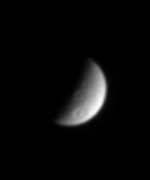
Image credit: NASA/JPL/SSI
This view of icy Tethys (1060 kilometers, 659 miles across) shows a large crater in the moon?s southern hemisphere with a central peak. Other surface details of this heavily cratered surface are faintly visible. Cassini was at the time speeding away from the Saturn system on its initial long, looping orbit.
The image was taken in visible light with the narrow angle camera on July 13, 2004, from a distance of about 4.8 million kilometers (3 million miles) from Tethys and at a Sun-Tethys-spacecraft, or phase, angle of 97 degrees. The image scale is 29 kilometers (18 miles) per pixel. The image has been magnified by a factor of two to aid visibility.
The Cassini-Huygens mission is a cooperative project of NASA, the European Space Agency and the Italian Space Agency. The Jet Propulsion Laboratory, a division of the California Institute of Technology in Pasadena, manages the Cassini-Huygens mission for NASA’s Office of Space Science, Washington, D.C. The imaging team is based at the Space Science Institute, Boulder, Colorado.
For more information about the Cassini-Huygens mission, visit http://saturn.jpl.nasa.gov and the Cassini imaging team home page, http://ciclops.org.
Original Source: CICLOPS
